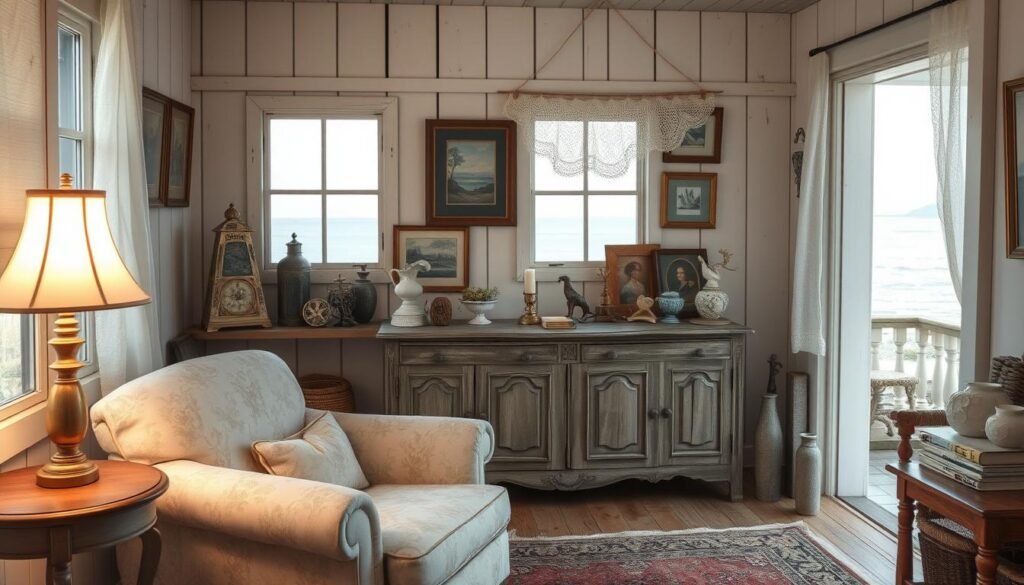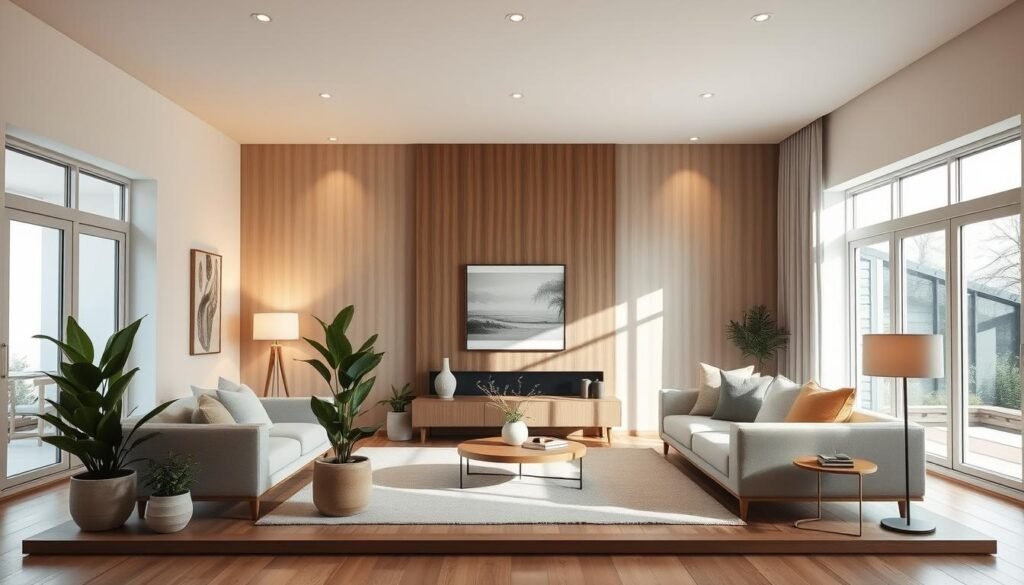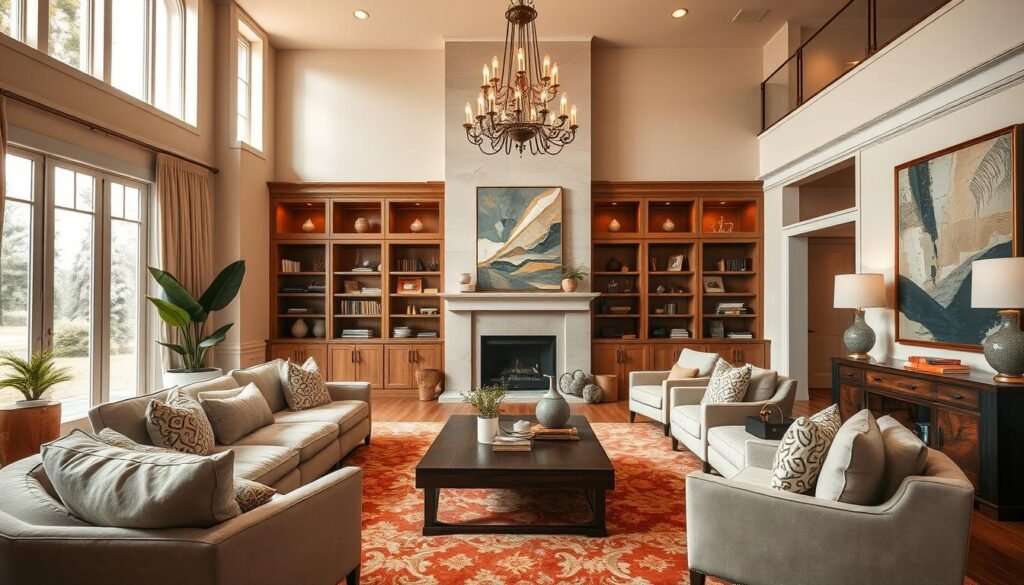Your living environment should tell your story without shouting it. As designer Lucie Ayres notes, crafting a well-themed home separates exceptional design from ordinary attempts. The challenge? Balancing personality with practicality so your space feels inviting, not like a movie set.
Many struggle to blend interior elements without creating clutter or stiffness. It’s about finding that sweet spot where your favorite colors, textures, and decor work together naturally. Think of it as curating a gallery that changes with your life.
Successful design considers how you actually use each room. Do you host dinners weekly? Love reading by natural light? Your daily habits should guide choices, ensuring both beauty and function. Start by identifying what makes you feel most at ease – that’s where authentic style begins.
Key Takeaways
- Your home should reflect personal stories through intentional decor choices
- Avoid stage-like setups by blending themes with functional layouts
- Daily routines should influence aesthetic decisions for lasting satisfaction
- Signature pieces create focal points without overwhelming rooms
- Timeless elements maintain appeal through changing trends
Understanding Your Personal Design Style
True interior harmony emerges when environments mirror their inhabitants’ essence. Your design style isn’t about labels – it’s the visual translation of what makes you feel grounded and energized. Start by noticing patterns in places where you naturally thrive.
Identifying Inspirations and Lifestyle
What colors calm you after a hectic day? Which textures make you want to linger? Professional organizers suggest reviewing your wardrobe and bookshelves – these often reveal unconscious preferences. Your lifestyle dictates practical needs: frequent hosts need durable fabrics, while remote workers require functional comfort.
Draw inspiration from:
- Memorable travel destinations that shaped your perspective
- Art movements or cultural motifs that spark joy
- Natural landscapes where you feel most at peace
Reflecting Your Personality in Home Decor
Your space should feel like your favorite sweater – comfortable yet expressive. Mix heirlooms with modern finds to create depth. A music lover might display vintage records as art; a gardener could incorporate botanical prints.
Consider these elements:
- Lighting that adapts to your daily mood cycles
- Wall colors enhancing your natural energy levels
- Functional decor serving dual purposes
Remember: Authenticity trumps trends. As designer Matthew Patrick Smyth observes, “The best rooms contain pieces with personal histories – they’re conversation starters that never go out of style.”
Exploring Popular Themes and Trends in Interiors
Great spaces become stories told through interior design choices. Whether drawn to crashing waves or streamlined silhouettes, your environment can mirror life’s chapters while staying rooted in practicality. Let’s explore how popular themes translate into livable artistry.

From Coastal to Vintage: A Visual Tour
Coastal interiors whisper relaxation through driftwood tones and linen textures. Think weathered finishes rather than anchor-shaped pillows – subtlety keeps spaces sophisticated. Layer seagrass rugs with cerulean accents for breezy elegance.
Vintage themes thrive on curated storytelling. Mix Depression-era glassware with mid-century ceramics to showcase design evolution. Designer Sarah Sherman Samuel advises, “Let patina shine – scratches add soul to spaces.”
Modern and Minimalist Considerations
Clean-lined modern interiors prioritize flow over fuss. Built-in storage hides clutter while neutral backdrops highlight architectural details. Matte black fixtures and streamlined seating create calm through reduction.
Key elements for success:
- Multifunctional furniture maximizing square footage
- Strategic negative space enhancing room proportions
- Monochromatic schemes punctuated with organic textures
Industrial and Scandinavian styles offer variations on this concept. Exposed beams meet warm wood tones in urban lofts, while Nordic interiors balance light woods with cozy textiles.
Expert Advice to pick a theme for home
Creating rooms that breathe requires equal parts vision and restraint. Top designers agree: successful spaces balance curated aesthetics with lived-in comfort. Let’s explore professional strategies for crafting environments that inspire without overwhelming.

Maintaining Balance and Authenticity
Annie Harrison of FARE INC notes: “Three strategic pieces often create more impact than twelve literal ones.” This philosophy shines in homes where a single artisan chair anchors a modern dining area, or handwoven textiles add texture to minimalist bedrooms.
Designers suggest this approach:
| Elements | Balanced Approach | Over-Themed Result |
|---|---|---|
| Furniture Selection | 2-3 statement pieces per room | Matching sets lacking personality |
| Color Usage | 60% neutral, 30% accent, 10% bold | Overwhelming monochromatic schemes |
| Decor Items | Mix heirlooms with contemporary art | Theme-branded accessories |
| Personal Touches | Family photos in stylish frames | Generic stock artwork |
Avoiding Over-Theming and Staged Looks
New York designer Kati Curtis observes: “Rooms should whisper your style, not scream it.” This means choosing lamps you actually use over purely decorative lighting, or opting for comfortable sectionals instead of delicate period furniture.
Professional designers recommend:
- Rotating seasonal decor rather than permanent installations
- Using functional items (bookcases, ottomans) as style vehicles
- Leaving 40% of surfaces clutter-free
Remember: Great design evolves. Start with foundational pieces, then layer personality gradually. Your space should feel like a favorite novel – rich with story, yet always leaving room for new chapters.
Layering Textures, Colors, and Accents for Depth
Great interiors reveal their character through thoughtful combinations. Like a well-composed song, rooms need rhythm created by varied textures and harmonious tones. Start with foundational elements, then build visual interest through contrasting finishes.
Mixing Materials and Finishes
Designer Annie Harrison proves wood and stone gain new life when paired with aged metals. Try linen cushions on a leather sofa or matte ceramics beside polished marble. These pairings create tactile experiences that invite touch while maintaining elegance.
Creating a Cohesive Color Palette
Professional designers use a 3:2:1 ratio for color success. Choose three core hues (like warm grays), two supporting tones (soft blues), and one pop of drama (burnt orange). Test swatches at different times – morning light reveals undertones evening shadows hide.
Incorporating Signature Decorative Pieces
Texas designer Kim Armstrong transformed a beach house using striped fabrics instead of seashell motifs. Her secret? Choose accents that hint at themes without shouting. A sculptural lamp or hand-carved bowl adds personality while serving practical needs.
| Element | Balanced Approach | Common Mistake |
|---|---|---|
| Material Mixing | 3 natural + 1 metallic texture | Too many competing finishes |
| Color Distribution | 60% base, 30% secondary, 10% accent | Equal color proportions |
| Signature Pieces | 1 focal item per zone | Multiple competing statements |
| Luxury Touches | Custom stone details | Overused metallic accents |
Room-Specific Strategies to Enhance Your Theme
Every room whispers its own design needs through daily use and mood requirements. Successful spaces balance aesthetics with purpose, using tailored approaches that honor each area’s unique role in your life. Let’s explore how to amplify character while maintaining functionality.
Tailoring Themes for Bedrooms and Living Spaces
Bedrooms thrive when color and lighting work together. Caroline Aston suggests warm pastels over sugary tones – think umber accents with soft turquoise walls. Layer blackout curtains with adjustable lamps to create restful environments that adapt from morning to night.
Living areas demand flexible furniture arrangements. Emily Henderson proves vintage counters make striking kitchen islands, while modular sectionals allow quick reconfigurations for movie nights or dinner parties. Keep walls neutral to let artwork and textiles shine during different events.
Designing Kid-Friendly and Flexible Spaces
Children’s rooms need themes that grow with them. Limit bold patterns to window treatments or removable wall panels. Aston recommends cherry red accents against butterscotch walls – vibrant yet mature enough for teenage years.
Smart solutions include:
- Multi-height storage units doubling as play surfaces
- Magnetic paint sections for rotating art displays
- Washable textiles in playful geometric prints
| Room Type | Color Strategy | Key Elements |
|---|---|---|
| Bedroom | Calming pastels + umber accents | Blackout layers + task lighting |
| Living Space | Neutral base + bold textiles | Modular seating + vintage accents |
| Kids’ Room | Mature pastels + cherry pops | Removable wall features + adaptable storage |
Blending Vintage Charm with Contemporary Flair
The magic of interior design lies in harmonizing eras without losing modern comfort. New York designer Lucie Ayres proves this in her Amagansett farmhouse project, where sleek Italian chairs add freshness to rustic bedrooms. It’s about creating dialogue between old soul and new energy.
Curating Statement Pieces and Modern Lines
Audrey Scheck advises treating vintage finds like supporting actors – let them shine without dominating. Her Texas projects pair 1960s Dutch chairs with oval tables, letting sculptural forms command attention. Statement furniture works best when surrounded by clean-lined companions that highlight its character.
Designers often use this formula:
- One heritage piece per zone (carved armoire, tufted bench)
- Modern lighting to ground historical elements
- Contemporary art prints as visual bridges between eras
Achieving Timeless Yet Trendy Interiors
Manhattan loft renovations showcase how terracotta urns gain relevance beside minimalist bookshelves. “Mix textures, not decades,” suggests Scheck. Velvet cushions on mid-century sofas or brass sconces flanking abstract paintings create layered narratives.
Key strategies include:
- Using vintage rugs to warm up polished concrete floors
- Pairing ornate frames with bold graphic prints
- Choosing neutral walls to let furniture eras converse
True balance comes when spaces feel collected, not decorated. As Ayres demonstrates, a single heirloom quilt can anchor a room full of modern furniture, proving old and new share more common ground than we think.
Conclusion
Great design evolves like a well-loved novel – its chapters adapt while keeping core themes intact. Professional interior design thrives when spaces balance self-expression with adaptability, blending your story with practical needs.
The secret? Treat your home as a living canvas. Choose elements that reflect your journey while leaving room for growth. Mix heirloom furnishings with modern accents to create depth that withstands trends.
Successful rooms work like trusted friends – comforting yet full of surprises. Designers recommend focusing on three essentials:
- Versatile foundations that adapt to life changes
- Meaningful decor sparking daily joy
- Neutral backdrops letting personality shine through accents
Remember: Timeless style isn’t about perfection. It’s crafting spaces that feel authentically yours while welcoming new chapters. As lighting dims and sunlight shifts, your best rooms will reveal layers of intention – designed not just to impress, but to embrace life’s beautiful mess.

